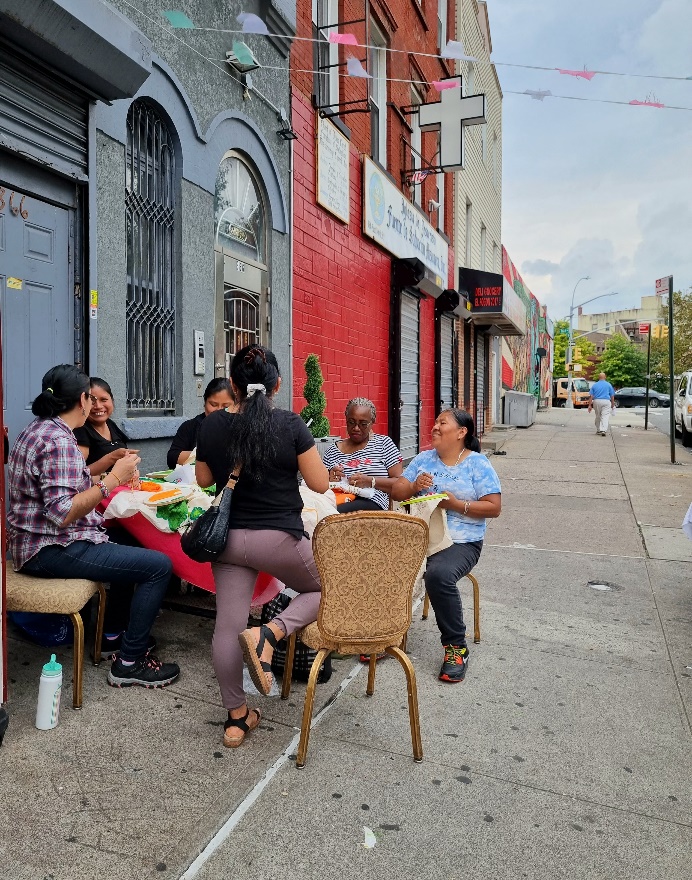Three days a week, Eufemia Neri arrives at 146th Street between Willis and Third Avenue at 11 a.m. with two bags: one with embroidery materials and the other with quesadillas and atole.
Minutes later, her colleagues arrive, turn on some cumbia music and install tables where they begin embroidering. No ambulance siren, car engine, or airplane turbines interrupts their harmonious circle.
Since May, Neri has led embroidery workshops every Wednesday, Thursday, and Saturday outside La Casa de Los Pueblos. The embroidery group offers an opportunity for the women to leave the house, meet and hang out with other women who share similar experiences.
From 11 a.m. to 2 p.m., these women ‘fix’ the South Bronx one stitch at a time.
“I am very, very happy because I have my little group that at least three days a week we meet, we eat, we embroider and we laugh for a while,” commented Neri.
The workshop emerged as a project of the Transnational People’s Network. This is a network in New York of immigrants from rural and indigenous communities in Latin America who work to achieve inclusion, economic and social justice for their people. The participants embroider tablecloths, napkins where they keep tortillas and sometimes handbags.
The members of the group are originally from states in Mexico and Honduras. Those from Mexico are mostly from the state of Guerrero and speak their Mixe or Nahuatl indigenous language while they embroider.
According to Mexican census data, the state of Guerrero has the highest rate of emigration to the United States. Guerrero has had a migratory thread to New York since 1980. The Bronx is one of the two New York neighborhoods where the highest percentage of Mexicans live. The majority of the embroiderers are indigenous people from Guerrero.
Although Neri has been in New York for 21 years, embroidery reminds her of her roots. In her hometown of Yerba Santa, Guerrero, she embroidered the napkins that are used to keep the tortillas warm – so there is no embroidery session without tortillas.
“You see, here, we bring our tradition, we eat hot tortillas with eggs, and salsa; This is what we hope we continue to maintain with our embroidery workshops,” said Neri. Then member Edith Escamilla nodded, “Exactly, the important thing is that it doesn’t get lost.”
Escamilla is from Guerrero too, and has been living in New York for 20 years. While she told personal anecdotes about her family experiences in the city, from access to medical services to discrimination, the others at the table nodded with understanding and openness. Comments of ‘I understand you’ and ‘the same thing happened to me’ generated sympathy in the circle that embraced Escamilla.
Mexican anthropologist Marcela Lagarde de los Ríos explained that embroidery generates relationships and allows exchanges of skills that translate into forms of care. Those forms of care end up being “feminine responsibilities associated with the care of others,” which are part of a historical process that shapes women as mothers and wives.
Sandra Brooks is one of the two women not from Mexico. She is Garifuna from Tela, Honduras and has been in the Bronx for 34 years. She is now retired and instead of staying at home, she goes out to embroider with her Mexican girlfriends.
“It’s not good for my mental health to stay at home all the time,” Brooks said. She affirms that she feels that the workshops are an “important” space, where she feels accompanied and welcomed.
Embroidery itself can tell personal stories, contain memories and gather groups to share stitching techniques such as the pescadito stitch, like Neri calls it, or back stitch. Likewise, they create paths of introspection and reflection that for some, reconcile and heal.
Embroidering in chain or cross stitch, members like Monica Martínez use embroidery as emotional support. Martínez emphasized that she feels “welcome and safe” in this space, something that did not happen so often in other places where prejudices abounded.
After lots of laughter, some gossip, pricked fingers, and handmade tortillas, 11 a.m. becomes 2 p.m. Neri puts the embroidery materials back into her bag, and they all help put the tables back into place.
With winter knocking on the door, the workshops are no longer outside. However, there will be no rain, snow, or cold to prevent these women gathering to embroider together.

